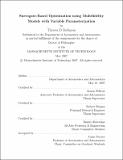Surrogate-based optimization using multifidelity models with variable parameterization
Author(s)
Robinson, Theresa Dawn, 1978-
DownloadFull printable version (2.123Mb)
Alternative title
SBO using multifidelity models with variable parameterization
Other Contributors
Massachusetts Institute of Technology. Dept. of Aeronautics and Astronautics.
Advisor
Karen Willcox and Robert Haimes.
Terms of use
Metadata
Show full item recordAbstract
Engineers are increasingly using high-fidelity models for numerical optimization. However, the computational cost of these models, combined with the large number of objective function and constraint evaluations required by optimization methods, can render such optimization computationally intractable. Surrogate-based optimization (SBO) - optimization using a lower-fidelity model most of the time, with occasional recourse to the high-fidelity model - is a proven method for reducing the cost of optimization. One branch of SBO uses lower-fidelity physics models of the same system as the surrogate. Until now however, surrogates using a different set of design variables from that of the high-fidelity model have not been available to use in a provably convergent numerical optimization. New methods are herein developed and demonstrated to reduce the computational cost of numerical optimization of variableparameterization problems, that is, problems for which the low-fidelity model uses a different set of design variables from the high-fidelity model. (cont.) Four methods are presented to perform mapping between variable-parameterization spaces, the last three of which are new: space mapping, corrected space mapping, a mapping based on proper orthogonal decomposition (POD), and a hybrid between POD mapping and space mapping. These mapping methods provide links between different models of the same system and have further applications beyond formal optimization strategies. On an unconstrained airfoil design problem, it achieved up to 40% savings in highfidelity function evaluations. On a constrained wing design problem it achieved 76% time savings, and on a bat flight design problem, it achieved 45% time savings. On a large-scale practical aerospace application, such time savings could represent weeks.
Description
Thesis (Ph. D.)--Massachusetts Institute of Technology, Dept. of Aeronautics and Astronautics, 2007. This electronic version was submitted by the student author. The certified thesis is available in the Institute Archives and Special Collections. Includes bibliographical references (p. 131-138).
Date issued
2007Department
Massachusetts Institute of Technology. Department of Aeronautics and AstronauticsPublisher
Massachusetts Institute of Technology
Keywords
Aeronautics and Astronautics.